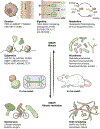Found in translation-Fibrosis in metabolic dysfunction-associated steatohepatitis (MASH)
- PMID: 37792957
- PMCID: PMC10671253
- DOI: 10.1126/scitranslmed.adi0759
Found in translation-Fibrosis in metabolic dysfunction-associated steatohepatitis (MASH)
Abstract
Metabolic dysfunction-associated steatohepatitis (MASH) is a severe form of liver disease that poses a global health threat because of its potential to progress to advanced fibrosis, leading to cirrhosis and liver cancer. Recent advances in single-cell methodologies, refined disease models, and genetic and epigenetic insights have provided a nuanced understanding of MASH fibrogenesis, with substantial cellular heterogeneity in MASH livers providing potentially targetable cell-cell interactions and behavior. Unlike fibrogenesis, mechanisms underlying fibrosis regression in MASH are still inadequately understood, although antifibrotic targets have been recently identified. A refined antifibrotic treatment framework could lead to noninvasive assessment and targeted therapies that preserve hepatocellular function and restore the liver's architectural integrity.
Figures



References
-
- Hossain P, Kawar B, El Nahas M, Obesity and Diabetes in the Developing World — A Growing Challenge. New England Journal of Medicine 356, 213–215 (2007). - PubMed
-
- Diehl AM, Day C, Cause, Pathogenesis, and Treatment of Nonalcoholic Steatohepatitis. New England Journal of Medicine 377, 2063–2072 (2017). - PubMed
-
- Loomba R, Friedman SL, Shulman GI, Mechanisms and disease consequences of nonalcoholic fatty liver disease. Cell 184, 2537–2564 (2021). - PubMed
-
- Leung JC-F, Loong TC-W, Wei JL, Wong GL-H, Chan AW-H, Choi PC-L, Shu SS-T, Chim AM-L, Chan HL-Y, Wong VW-S, Histological severity and clinical outcomes of nonalcoholic fatty liver disease in nonobese patients. Hepatology 65, 54–64 (2017). - PubMed
Publication types
MeSH terms
Grants and funding
LinkOut - more resources
Full Text Sources
Medical

